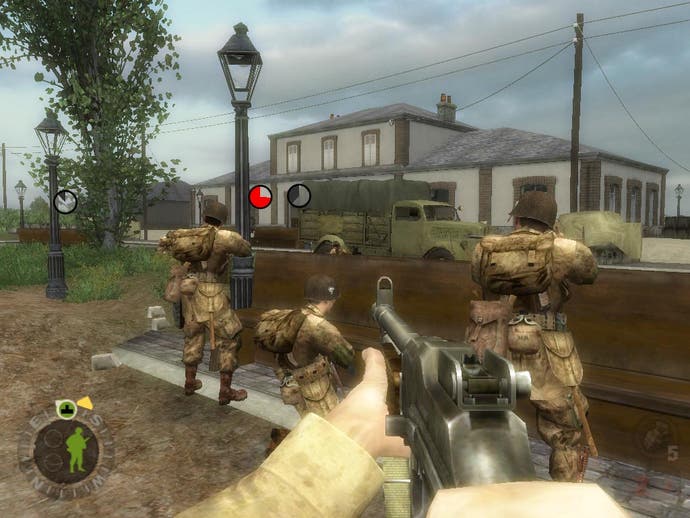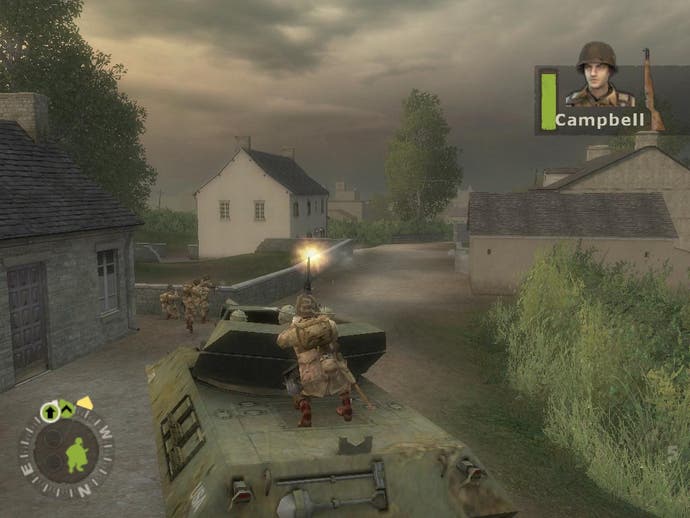Brothers in Arms: Earned in Blood
Real men don't use medipacks.
In a step that risks setting back the cause of progressive games reviewing several years here are five things that I loathe about Brothers In Arms: Earned In Blood.
Number One. Anyone getting their WW2 education primarily from this game would think that the German army's sole preparation for D-Day was to commandeer every single crate, barrel and oil drum in Western Europe, ship them to Normandy, then arrange them in neat barriers every twenty metres or so.
Number Two. (and this is connected to number one) What in God's name do the good people of north-west France manufacture their doors from? It has to be some-kind of bullet-proof, boot-proof miracle timber; why else would soldiers on both sides insist on doing 98 per cent of their fighting in the open air.
Number Three. Were the American's toughest troopers really so out-of-condition in 1944 that they couldn't break-into a sprint or clamber over a low wall? Were they really so encumbered with kit that they wouldn't lean round corners just in case the weight of grenades hanging from their webbing caused them to topple over and flounder on the ground like upturned beetles. The fear of falling and never being able to get up again would certainly explain why troops are so reluctant to press their bellies into the damp protective Normandy earth.
Number Four. Did Gearbox's set-out to create one of the nastiest grenade hurling systems known to Man or was it just a happy accident? Pineapple-tossing is obviously more art than science but should I really have to stare at the sky and cross my fingers to hit a barn-door just across the lane.

Number Five. If contemporary shooters have a list of golden rules then somewhere very near the top must be "If you can see it then you should be able to put a slug in it." Though EiB seems slightly better than Road to Hill 30 in this respect, there are still too many occasions where you pop away for ages at exposed helmets (anyone that so much as sniggers at that remark will get an instant detention) and do no damage whatsoever.
There we go then. Five things I hate about EiB. Now for the five reasons why I think it's the finest ww2 shooter around.
Reason One (a biggy): One of the most impressive aspects of Brothers In Arms: Road to Hill 30 game was the emphasis it puts on genuine squad tactics. Lone-wolf glory hunting and narrow assaults were usually (at the higher difficulty levels at least) ruthlessly punished. To succeed you had to 'fix' enemies with suppressing fire using one of your two controllable teams, then flank and eliminate them. This was great fun up to a point, that point being the hundredth time you flanked the hundredth knot of Nazis cowering obediently behind the hundredth wall of crates. The Germans were just too static and predictable in RTH30. That's all changed in EiB. Now you regularly find yourself outflanked and out-thought. Foes may spot you creeping round behind them and make dashes for better positions. This makes for wonderfully chaotic and replayable battles. Example? In one particularly tough story mission (Hedgerow Hell) I'd followed the same tactics three times in a row and come to grief each time. On the fourth try I positioned a covering team in a slightly different spot then advanced down a ditch that had previously been completely deserted and safe. This time I ran right into a pair of relocating Jerries who, in the ensuing point-blank firefight, left me staring at the sky through a veil of seeping blood.

Reason Two: EiB provides an absorbing alternative to its central story mode in the shape of ten standalone skirmish battles. These can be relished as two (one German, one American) mini campaigns or, more interestingly, as highly configurable one-off challenges. Fancy facing foes that can't shoot for toffee but have nerves of Krupps steel? Want to play a scenario against the clock or as a desperate 'pop til you drop' defensive suicide mission? It's all possible. Not only are there numerous ways to tweak these longevity-bestowing skirmish fights they can also be enjoyed as memorable two-player co-op kill safaris.
Reasons Three: The first third of EiB's 13 story missions are set in exactly the same neck-of-the-Normandy-woods that featured in RTH30. Later you get to frolic in the ruins and rail yards of towns like Carentan but even so it's hard to describe this game's primarily rural settings as particularly varied or dramatic. Is this a weakness? If you're after a globe-trotting CoD-style experience then probably. If, however, you're after a game environment that gets under your skin and your fingernails, giving you a tiny insight into what it must have been like to slog through 'Bocage' country grappling for every hamlet, village, and cabbage patch, then it's almost certainly a strength.

Reason Four: The locales may blur, but the missions are distinctive and well constructed. With a couple of exceptions - one rather silly tank luring exercise and a bizarre 'blow-up ten hedges to reach objective' jaunt - they all feature the kind of gripping yet mundane activities that fill accounts like Band of Brothers. Silencing AT guns and MG nests, dealing with stray panzers, hunting-down mortar batteries, wheedling infantry from gardens, farms and hedge-lines... the bread-and-butter brutality of Operation Overlord.
Reason Five is slightly nebulous but worth stating all the same. EiB feels grittier - closer to its fascinating yet fearful inspiration - than any other military shooter out there. Much of that feel comes from the credible mission design and AI already mentioned but a significant portion stems from fundamentals like the way the weapons look, sound and perform. Gun sway has been reduced slightly for this sequel but shooting is still credibly hard. When you peer down the atmospheric iron sights of old favourites like the BAR and M1 or new weapons like the Grease Gun and the FG44 you don't have that ridiculous confidence that you get in other martial FPS. Just because a distant target is under your bobbing bead doesn't mean it's going to instantly crumple when you eagerly tug the trigger. You and your killing device are fallible. War is cruel like that.







